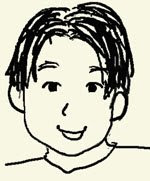Here I would like to show the summary of "Learning Patterns". Currently, learning patterns consist of 40 patterns and are organized in three layers according to the abstract level. In the top layer, there is a root pattern; Learning Design (0). In the second layer, there are three patterns; Grasp of Cimmunity's Mind (1), Project-Centered Learning (2) and Community as "Becoming" (3). In the third layer, there are thirty-six patterns as concrete `knack' of learning; Tornado of Learning (4), Academic Excitement! (5), and so on.

All 40 patterns together form a language for creative learning. We begin with the part of the language which define learning design itself. This is the fundamental and premise to use this pattern language;
0. Learning Design
Next, we shall go through the part of the language which gives you comprehensive attitude for learning;
1. Grasp of Community's Mind
2. Project-Centered Learning
3. Community as "Becoming"
Now we start the part of the language which tells how you can achieve to learn more creatively in detail. This part can be roughly divided into twelve groups of patterns, where each group consists of three patterns respectively.
First group of patterns is related to motivation and fundamental aspect of learning;
4. Tornado of Learning
5. Academic Excitement!
6. Passion for Research
Second group of patterns shows the key to start your learning;
7. First Steep
8. Mimic Learning
9. Good Learner
Third group of patterns treats how to acquire and improve your skill;
10. Embodied Learning
11. Discovery of Growth
12. Shower of Language
Forth group of patterns tells how to make your learning more interesting;
13. Output-Driven Learning
14. Prototyping
15. Learning for Fun
Fifth group of patterns reminds the significance of active effort;
16. Thinking in Action
17. Field Dive
18. Weak-Linked Encounter
Sixth group of patterns is related to the scope of learning;
19. Frontier Antenna
20. T-Shape Learning
21. Hidden Connections
Seventh group of patterns give key ideas for innovative thinking;
22. Brain Switch
23. Bird's Eye, Bug's Eye
24. Quality from Quantity
Eighth group of patterns is related to the way of going about activity and learning;
25. Self-Thinking
26. Appropriate Approach
27. Strategic Discard
Ninth group of patterns is about social aspect of learning;
28. Community of Learning
29. Release of Thoughts
30. Good Rival
Tenth group of patterns mentions how to improve your skill or works;
31. Leaning by Teaching
32. Everyday in Foreign Language
33. Start Small, Let it Grow
Eleventh group of patterns is important idea for the final phase of activity;
34. Attractive Expression
35. Writing up is Halfway
36. Acceleration to Next
Twelfth group of patterns tells the strategy for the medium and long term;
37. Self-Producing
38. Firm Determination
39. Be Extreme!
The sequence presented here is not only one possible sequence, because "A pattern language has the structure of a network"(Alexander 1977). We can capture and trace the relation among the patterns in many way. This is related to one of Alexander's significant findings that the design of a building and a town cannot be reduced to the structure of tree, but can considered as semi-lattice, namely network.
In the catalog, there are some navigations to find the patterns. One of the navigation is based on contexts of patterns. There are five categories of contexts; "at beginning", "for goal setting", "in activity", "for output", and "at dead end". Each category consists of four contexts, which indicate to related patterns respectively. Therefore the reader can find patterns that are relevant to their situation.

Another navigation in the catalog is provided in association with the curriculum of our university. Each course indicates to related patterns, therefore the student can find the patterns that are relevant to the classes they are taking.

our language system is by far one of the most complicated of nature and trying to carry out studies to learn more about their development in a step we must find firmness
ReplyDeleteThat was a well written summary!
ReplyDeletepg 1
ReplyDeleteadidas yeezy
air jordan 1
100% real jordans for cheap
bape
supreme clothing
golden goose sneakers
yeezy shoes
jordan 6
steph curry shoes